Financial Decision Report: Analyzing SKANSA plc Financial Decisions
VerifiedAdded on 2022/12/22
|14
|3958
|54
Report
AI Summary
This report provides a comprehensive analysis of SKANSA plc's financial decisions, focusing on the importance of accounting and finance functions within a business context. It begins with an introduction to financial decisions, including financing, investing, and dividend decisions. The report then delves into the roles and duties of accounting and finance teams, highlighting their significance in maintaining financial records, avoiding legal issues, and facilitating internal and external communication. Task 1 emphasizes the importance of accounting and finance in business, while Task 2 focuses on ratio analysis to evaluate SKANSA plc's performance over two years. The report covers various financial ratios, including return on capital employed, net profit margin, current ratio, and turnover ratios for debtors and creditors. The analysis includes interpreting the results, identifying potential causes for any poor performance, and suggesting strategies to improve profitability, liquidity, and efficiency. The report concludes with a summary of the findings and recommendations for future financial decision-making at SKANSA plc.

Financial Decision
Paraphrase This Document
Need a fresh take? Get an instant paraphrase of this document with our AI Paraphraser
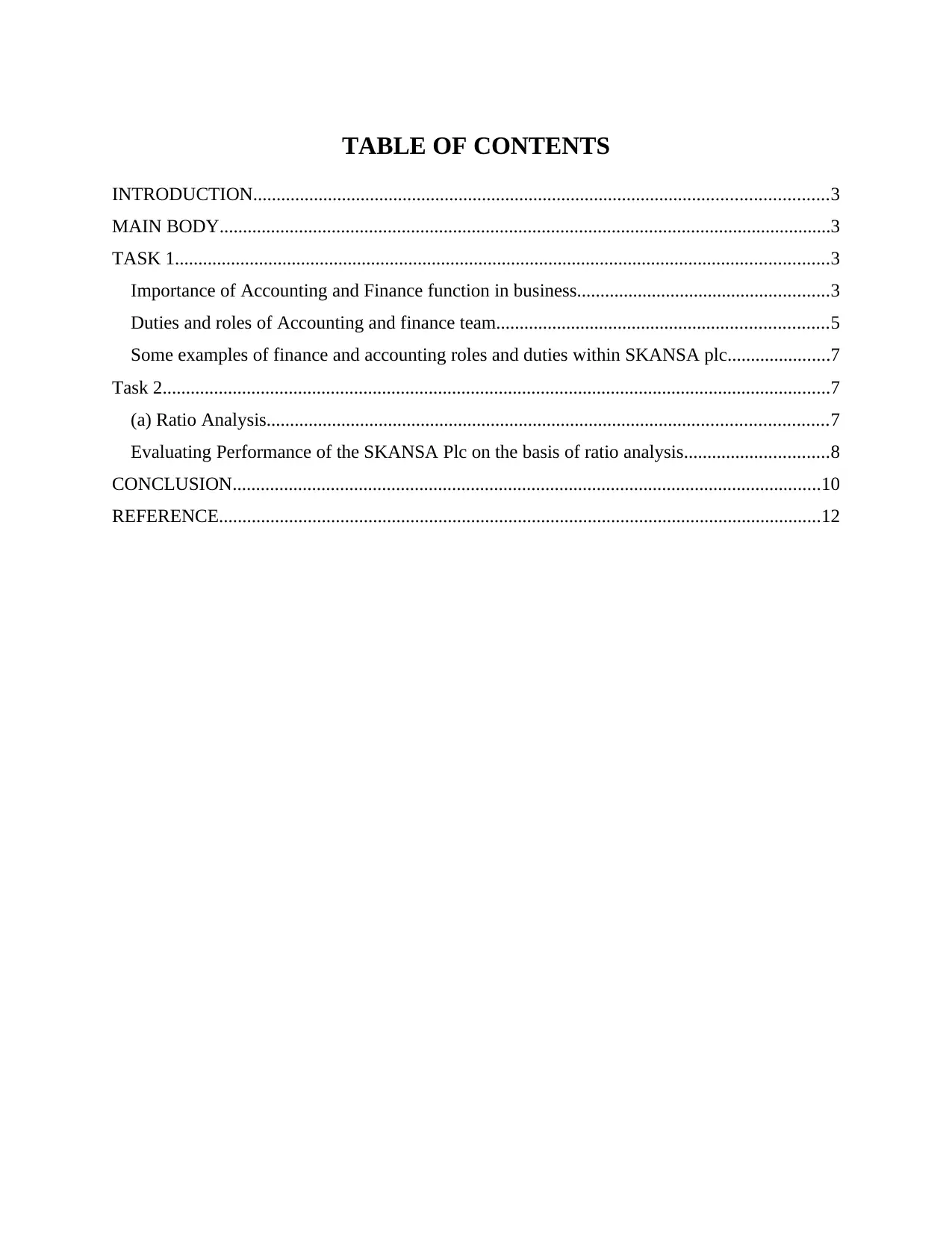
TABLE OF CONTENTS
INTRODUCTION...........................................................................................................................3
MAIN BODY...................................................................................................................................3
TASK 1............................................................................................................................................3
Importance of Accounting and Finance function in business......................................................3
Duties and roles of Accounting and finance team.......................................................................5
Some examples of finance and accounting roles and duties within SKANSA plc......................7
Task 2...............................................................................................................................................7
(a) Ratio Analysis........................................................................................................................7
Evaluating Performance of the SKANSA Plc on the basis of ratio analysis...............................8
CONCLUSION..............................................................................................................................10
REFERENCE.................................................................................................................................12
INTRODUCTION...........................................................................................................................3
MAIN BODY...................................................................................................................................3
TASK 1............................................................................................................................................3
Importance of Accounting and Finance function in business......................................................3
Duties and roles of Accounting and finance team.......................................................................5
Some examples of finance and accounting roles and duties within SKANSA plc......................7
Task 2...............................................................................................................................................7
(a) Ratio Analysis........................................................................................................................7
Evaluating Performance of the SKANSA Plc on the basis of ratio analysis...............................8
CONCLUSION..............................................................................................................................10
REFERENCE.................................................................................................................................12

INTRODUCTION
Financial decision is related to the crucial decision, in which all company's need to make
it appropriate in order to improve business performance. Such an decision includes financing,
investing and dividend decisions. The managers of accounting and finance plays important role
in such an task. So for this purpose, the report will cover the ration analysis of the SKANSA plc
of the two year (Kim and Im, 2017). The report will also interpret the result of such analysis and
identify the possible causes and reason behind any poor performance. After that the report will
also state the possible changes that the company will make in order to improve their profitability,
liquidity and efficiency ratio. The report also describe this all concept and analysis along with the
importance of accounting and finance in any company and the role of the finance managers in
managing the finance related task of the company.
MAIN BODY
TASK 1
Importance of Accounting and Finance function in business
Accounting and finance is the most important function performed in every business.
Management is very much concern about the business financial and accounting aspects. Many
times there are two different departments found within the company carrying out accounting and
finance functions individually (Mensah and Gbadago, 20180. Accounting function again
performed in different aspects such as, financial accounting for finding out about the financial
performance and position of the business in the period preceding the performance of financial
accounting. Another branch of accounting is management accounting, which is concerned with
forecasting and budgeting future aspects of the business. Next is auditing function which is
performed by accounting team, where a separate auditor is hired by company's (SKANSA Plc),
and the auditor is responsible for performing the task of determining whether the financial
statement duly prepared by the company is accurate or not. Also, whether the company's
financial statements are indicating going concern principle and company's solvency or not. At
last auditing function is meant for ensuring that the company is complying with legal obligations
applicable on it.
Financial decision is related to the crucial decision, in which all company's need to make
it appropriate in order to improve business performance. Such an decision includes financing,
investing and dividend decisions. The managers of accounting and finance plays important role
in such an task. So for this purpose, the report will cover the ration analysis of the SKANSA plc
of the two year (Kim and Im, 2017). The report will also interpret the result of such analysis and
identify the possible causes and reason behind any poor performance. After that the report will
also state the possible changes that the company will make in order to improve their profitability,
liquidity and efficiency ratio. The report also describe this all concept and analysis along with the
importance of accounting and finance in any company and the role of the finance managers in
managing the finance related task of the company.
MAIN BODY
TASK 1
Importance of Accounting and Finance function in business
Accounting and finance is the most important function performed in every business.
Management is very much concern about the business financial and accounting aspects. Many
times there are two different departments found within the company carrying out accounting and
finance functions individually (Mensah and Gbadago, 20180. Accounting function again
performed in different aspects such as, financial accounting for finding out about the financial
performance and position of the business in the period preceding the performance of financial
accounting. Another branch of accounting is management accounting, which is concerned with
forecasting and budgeting future aspects of the business. Next is auditing function which is
performed by accounting team, where a separate auditor is hired by company's (SKANSA Plc),
and the auditor is responsible for performing the task of determining whether the financial
statement duly prepared by the company is accurate or not. Also, whether the company's
financial statements are indicating going concern principle and company's solvency or not. At
last auditing function is meant for ensuring that the company is complying with legal obligations
applicable on it.
⊘ This is a preview!⊘
Do you want full access?
Subscribe today to unlock all pages.

Trusted by 1+ million students worldwide

Finance function is also a very important function concerned with making decision
related to investments, procuring and utilizing finance in the business, providing reasonable
returns to the shareholders and ensuring sufficient working capital within the company. There are
much importance of these two broad functions that is, accounting and finance within each
business.
Accounting provides for keeping financial records of the business for long term: By
performing the function of accounting, company's can keep records of their financial activities,
where tracking of income and expenses can be easily performed and the same can be helpful in
managing future cash flows and finance related aspects.
Accounting and finance aids in avoiding legal problems: If accurate recording of financial
activities is done, then the following of laws applicable on SKANSA Plc can become possible.
As there would be a major problem if any minor detail of the business would be ignored.
Financial managers concerned with the performance of accounting and finance functions must do
it with an utmost care as poor financial recording may put your business in legal troubles.
It provides tools on the basis of which financial performance can be analysed easily:
Management and owners can see whether their business is performing well or not (Serrano-
Cinca, Gutiérrez-Nieto and Bernate-Valbuena, 2019). An assessment can be done on the basis of
comparison between current and historic performance of the business just by looking at its assets
and liabilities. So, financial managers and owner at SKANSA Plc can make out how well it is
doing by looking at its financial statements. Such analysis of performance helps in learning from
mistakes and ensuring lucrative future.
External and Internal communication can be well facilitated: Financial and accounting
function helps in communicating financial performance of the company (SKANSA plc) to both
external parties and internal stakeholders associated with the company in some or the other way.
Appropriate performance of this function helps in attracting investors and accordingly procuring
finance for the company. It also communicates strengths and weaknesses of the business and
necessary steps can be taken as earlier possible.
Strategy development can become possible: An appropriate strategy can be developed by
performing accounting and finance functions in the best possible manner. A close and an
appropriate review of financial statements helps in making informed financial decision. An
related to investments, procuring and utilizing finance in the business, providing reasonable
returns to the shareholders and ensuring sufficient working capital within the company. There are
much importance of these two broad functions that is, accounting and finance within each
business.
Accounting provides for keeping financial records of the business for long term: By
performing the function of accounting, company's can keep records of their financial activities,
where tracking of income and expenses can be easily performed and the same can be helpful in
managing future cash flows and finance related aspects.
Accounting and finance aids in avoiding legal problems: If accurate recording of financial
activities is done, then the following of laws applicable on SKANSA Plc can become possible.
As there would be a major problem if any minor detail of the business would be ignored.
Financial managers concerned with the performance of accounting and finance functions must do
it with an utmost care as poor financial recording may put your business in legal troubles.
It provides tools on the basis of which financial performance can be analysed easily:
Management and owners can see whether their business is performing well or not (Serrano-
Cinca, Gutiérrez-Nieto and Bernate-Valbuena, 2019). An assessment can be done on the basis of
comparison between current and historic performance of the business just by looking at its assets
and liabilities. So, financial managers and owner at SKANSA Plc can make out how well it is
doing by looking at its financial statements. Such analysis of performance helps in learning from
mistakes and ensuring lucrative future.
External and Internal communication can be well facilitated: Financial and accounting
function helps in communicating financial performance of the company (SKANSA plc) to both
external parties and internal stakeholders associated with the company in some or the other way.
Appropriate performance of this function helps in attracting investors and accordingly procuring
finance for the company. It also communicates strengths and weaknesses of the business and
necessary steps can be taken as earlier possible.
Strategy development can become possible: An appropriate strategy can be developed by
performing accounting and finance functions in the best possible manner. A close and an
appropriate review of financial statements helps in making informed financial decision. An
Paraphrase This Document
Need a fresh take? Get an instant paraphrase of this document with our AI Paraphraser
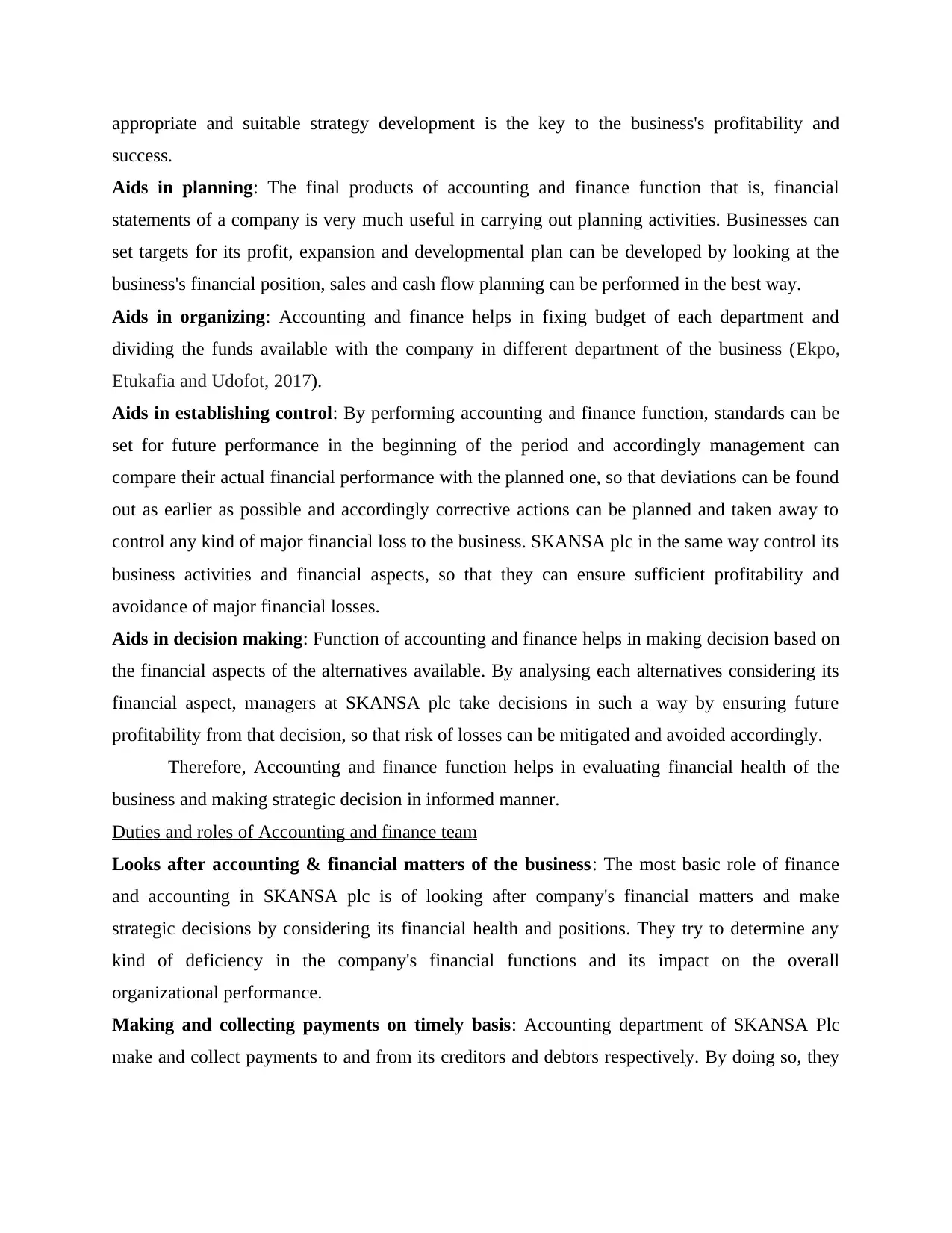
appropriate and suitable strategy development is the key to the business's profitability and
success.
Aids in planning: The final products of accounting and finance function that is, financial
statements of a company is very much useful in carrying out planning activities. Businesses can
set targets for its profit, expansion and developmental plan can be developed by looking at the
business's financial position, sales and cash flow planning can be performed in the best way.
Aids in organizing: Accounting and finance helps in fixing budget of each department and
dividing the funds available with the company in different department of the business (Ekpo,
Etukafia and Udofot, 2017).
Aids in establishing control: By performing accounting and finance function, standards can be
set for future performance in the beginning of the period and accordingly management can
compare their actual financial performance with the planned one, so that deviations can be found
out as earlier as possible and accordingly corrective actions can be planned and taken away to
control any kind of major financial loss to the business. SKANSA plc in the same way control its
business activities and financial aspects, so that they can ensure sufficient profitability and
avoidance of major financial losses.
Aids in decision making: Function of accounting and finance helps in making decision based on
the financial aspects of the alternatives available. By analysing each alternatives considering its
financial aspect, managers at SKANSA plc take decisions in such a way by ensuring future
profitability from that decision, so that risk of losses can be mitigated and avoided accordingly.
Therefore, Accounting and finance function helps in evaluating financial health of the
business and making strategic decision in informed manner.
Duties and roles of Accounting and finance team
Looks after accounting & financial matters of the business: The most basic role of finance
and accounting in SKANSA plc is of looking after company's financial matters and make
strategic decisions by considering its financial health and positions. They try to determine any
kind of deficiency in the company's financial functions and its impact on the overall
organizational performance.
Making and collecting payments on timely basis: Accounting department of SKANSA Plc
make and collect payments to and from its creditors and debtors respectively. By doing so, they
success.
Aids in planning: The final products of accounting and finance function that is, financial
statements of a company is very much useful in carrying out planning activities. Businesses can
set targets for its profit, expansion and developmental plan can be developed by looking at the
business's financial position, sales and cash flow planning can be performed in the best way.
Aids in organizing: Accounting and finance helps in fixing budget of each department and
dividing the funds available with the company in different department of the business (Ekpo,
Etukafia and Udofot, 2017).
Aids in establishing control: By performing accounting and finance function, standards can be
set for future performance in the beginning of the period and accordingly management can
compare their actual financial performance with the planned one, so that deviations can be found
out as earlier as possible and accordingly corrective actions can be planned and taken away to
control any kind of major financial loss to the business. SKANSA plc in the same way control its
business activities and financial aspects, so that they can ensure sufficient profitability and
avoidance of major financial losses.
Aids in decision making: Function of accounting and finance helps in making decision based on
the financial aspects of the alternatives available. By analysing each alternatives considering its
financial aspect, managers at SKANSA plc take decisions in such a way by ensuring future
profitability from that decision, so that risk of losses can be mitigated and avoided accordingly.
Therefore, Accounting and finance function helps in evaluating financial health of the
business and making strategic decision in informed manner.
Duties and roles of Accounting and finance team
Looks after accounting & financial matters of the business: The most basic role of finance
and accounting in SKANSA plc is of looking after company's financial matters and make
strategic decisions by considering its financial health and positions. They try to determine any
kind of deficiency in the company's financial functions and its impact on the overall
organizational performance.
Making and collecting payments on timely basis: Accounting department of SKANSA Plc
make and collect payments to and from its creditors and debtors respectively. By doing so, they
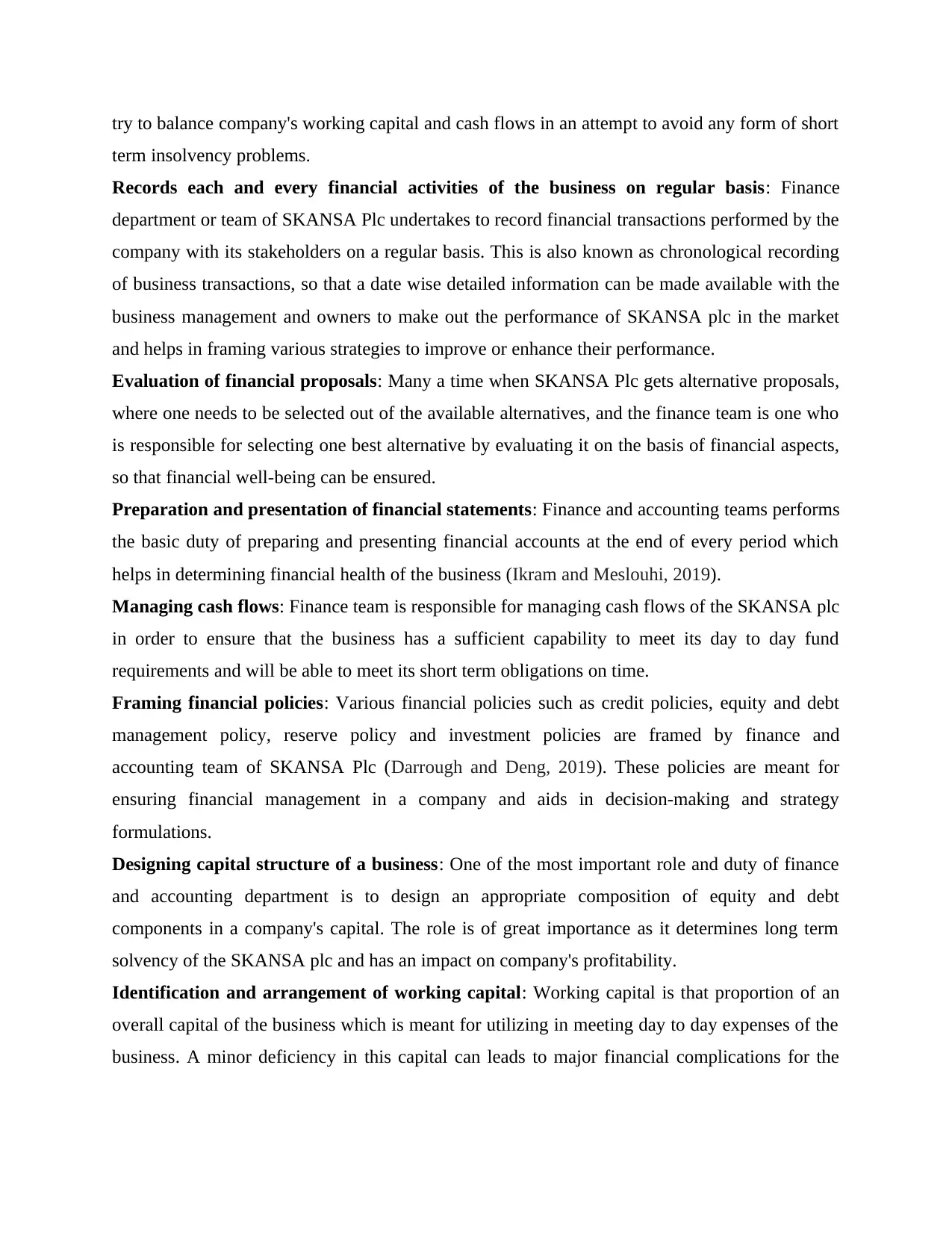
try to balance company's working capital and cash flows in an attempt to avoid any form of short
term insolvency problems.
Records each and every financial activities of the business on regular basis: Finance
department or team of SKANSA Plc undertakes to record financial transactions performed by the
company with its stakeholders on a regular basis. This is also known as chronological recording
of business transactions, so that a date wise detailed information can be made available with the
business management and owners to make out the performance of SKANSA plc in the market
and helps in framing various strategies to improve or enhance their performance.
Evaluation of financial proposals: Many a time when SKANSA Plc gets alternative proposals,
where one needs to be selected out of the available alternatives, and the finance team is one who
is responsible for selecting one best alternative by evaluating it on the basis of financial aspects,
so that financial well-being can be ensured.
Preparation and presentation of financial statements: Finance and accounting teams performs
the basic duty of preparing and presenting financial accounts at the end of every period which
helps in determining financial health of the business (Ikram and Meslouhi, 2019).
Managing cash flows: Finance team is responsible for managing cash flows of the SKANSA plc
in order to ensure that the business has a sufficient capability to meet its day to day fund
requirements and will be able to meet its short term obligations on time.
Framing financial policies: Various financial policies such as credit policies, equity and debt
management policy, reserve policy and investment policies are framed by finance and
accounting team of SKANSA Plc (Darrough and Deng, 2019). These policies are meant for
ensuring financial management in a company and aids in decision-making and strategy
formulations.
Designing capital structure of a business: One of the most important role and duty of finance
and accounting department is to design an appropriate composition of equity and debt
components in a company's capital. The role is of great importance as it determines long term
solvency of the SKANSA plc and has an impact on company's profitability.
Identification and arrangement of working capital: Working capital is that proportion of an
overall capital of the business which is meant for utilizing in meeting day to day expenses of the
business. A minor deficiency in this capital can leads to major financial complications for the
term insolvency problems.
Records each and every financial activities of the business on regular basis: Finance
department or team of SKANSA Plc undertakes to record financial transactions performed by the
company with its stakeholders on a regular basis. This is also known as chronological recording
of business transactions, so that a date wise detailed information can be made available with the
business management and owners to make out the performance of SKANSA plc in the market
and helps in framing various strategies to improve or enhance their performance.
Evaluation of financial proposals: Many a time when SKANSA Plc gets alternative proposals,
where one needs to be selected out of the available alternatives, and the finance team is one who
is responsible for selecting one best alternative by evaluating it on the basis of financial aspects,
so that financial well-being can be ensured.
Preparation and presentation of financial statements: Finance and accounting teams performs
the basic duty of preparing and presenting financial accounts at the end of every period which
helps in determining financial health of the business (Ikram and Meslouhi, 2019).
Managing cash flows: Finance team is responsible for managing cash flows of the SKANSA plc
in order to ensure that the business has a sufficient capability to meet its day to day fund
requirements and will be able to meet its short term obligations on time.
Framing financial policies: Various financial policies such as credit policies, equity and debt
management policy, reserve policy and investment policies are framed by finance and
accounting team of SKANSA Plc (Darrough and Deng, 2019). These policies are meant for
ensuring financial management in a company and aids in decision-making and strategy
formulations.
Designing capital structure of a business: One of the most important role and duty of finance
and accounting department is to design an appropriate composition of equity and debt
components in a company's capital. The role is of great importance as it determines long term
solvency of the SKANSA plc and has an impact on company's profitability.
Identification and arrangement of working capital: Working capital is that proportion of an
overall capital of the business which is meant for utilizing in meeting day to day expenses of the
business. A minor deficiency in this capital can leads to major financial complications for the
⊘ This is a preview!⊘
Do you want full access?
Subscribe today to unlock all pages.

Trusted by 1+ million students worldwide
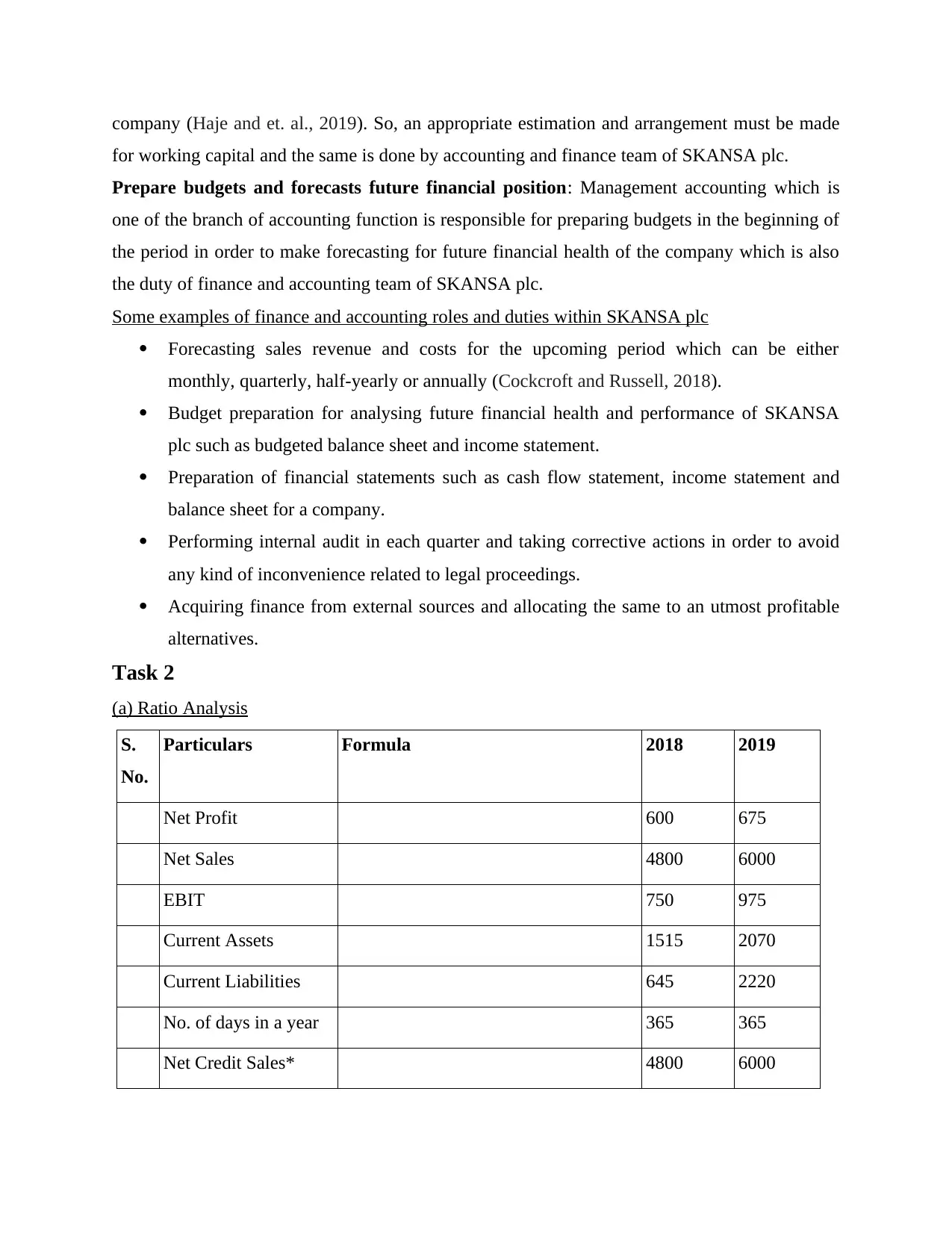
company (Haje and et. al., 2019). So, an appropriate estimation and arrangement must be made
for working capital and the same is done by accounting and finance team of SKANSA plc.
Prepare budgets and forecasts future financial position: Management accounting which is
one of the branch of accounting function is responsible for preparing budgets in the beginning of
the period in order to make forecasting for future financial health of the company which is also
the duty of finance and accounting team of SKANSA plc.
Some examples of finance and accounting roles and duties within SKANSA plc
Forecasting sales revenue and costs for the upcoming period which can be either
monthly, quarterly, half-yearly or annually (Cockcroft and Russell, 2018).
Budget preparation for analysing future financial health and performance of SKANSA
plc such as budgeted balance sheet and income statement.
Preparation of financial statements such as cash flow statement, income statement and
balance sheet for a company.
Performing internal audit in each quarter and taking corrective actions in order to avoid
any kind of inconvenience related to legal proceedings.
Acquiring finance from external sources and allocating the same to an utmost profitable
alternatives.
Task 2
(a) Ratio Analysis
S.
No.
Particulars Formula 2018 2019
Net Profit 600 675
Net Sales 4800 6000
EBIT 750 975
Current Assets 1515 2070
Current Liabilities 645 2220
No. of days in a year 365 365
Net Credit Sales* 4800 6000
for working capital and the same is done by accounting and finance team of SKANSA plc.
Prepare budgets and forecasts future financial position: Management accounting which is
one of the branch of accounting function is responsible for preparing budgets in the beginning of
the period in order to make forecasting for future financial health of the company which is also
the duty of finance and accounting team of SKANSA plc.
Some examples of finance and accounting roles and duties within SKANSA plc
Forecasting sales revenue and costs for the upcoming period which can be either
monthly, quarterly, half-yearly or annually (Cockcroft and Russell, 2018).
Budget preparation for analysing future financial health and performance of SKANSA
plc such as budgeted balance sheet and income statement.
Preparation of financial statements such as cash flow statement, income statement and
balance sheet for a company.
Performing internal audit in each quarter and taking corrective actions in order to avoid
any kind of inconvenience related to legal proceedings.
Acquiring finance from external sources and allocating the same to an utmost profitable
alternatives.
Task 2
(a) Ratio Analysis
S.
No.
Particulars Formula 2018 2019
Net Profit 600 675
Net Sales 4800 6000
EBIT 750 975
Current Assets 1515 2070
Current Liabilities 645 2220
No. of days in a year 365 365
Net Credit Sales* 4800 6000
Paraphrase This Document
Need a fresh take? Get an instant paraphrase of this document with our AI Paraphraser
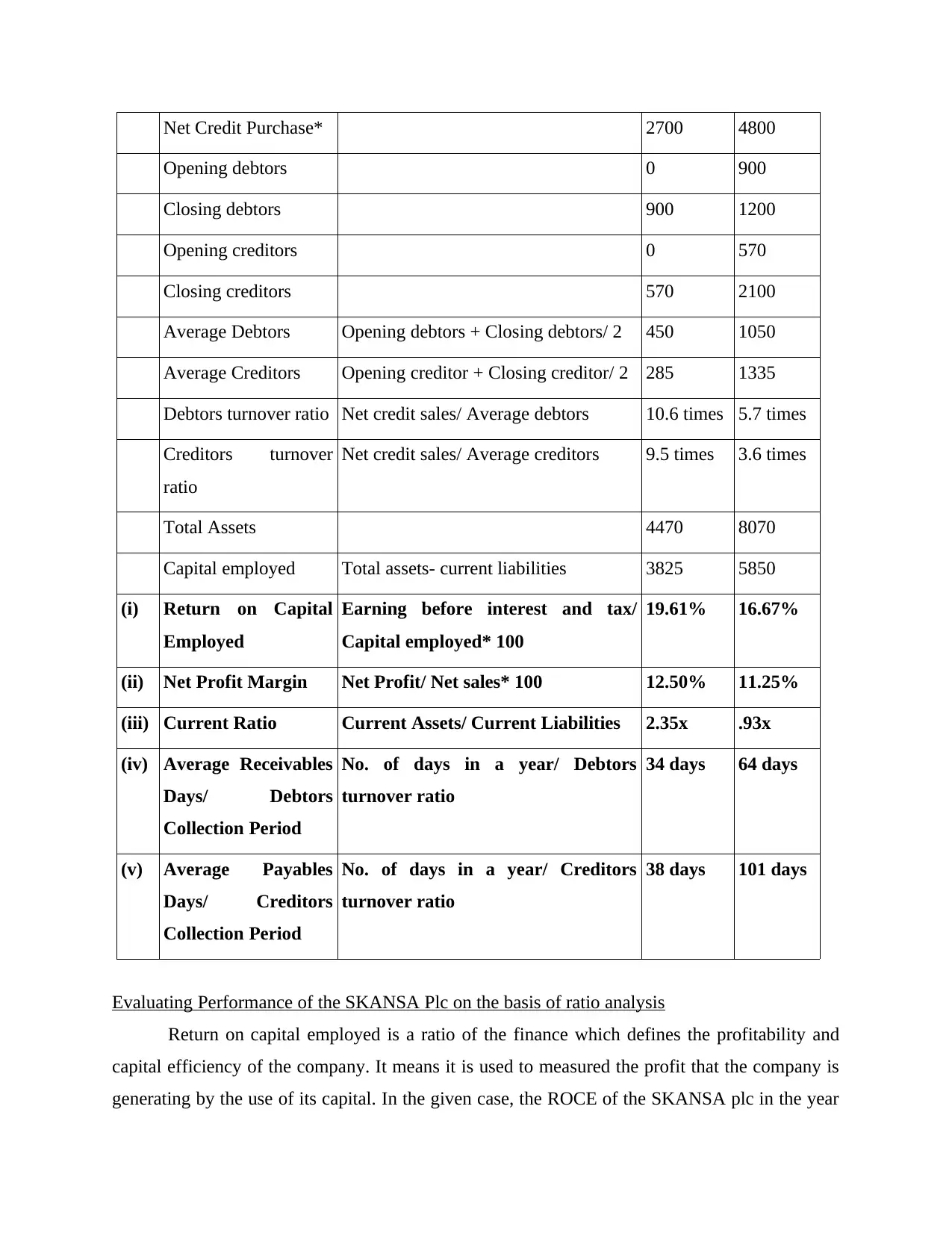
Net Credit Purchase* 2700 4800
Opening debtors 0 900
Closing debtors 900 1200
Opening creditors 0 570
Closing creditors 570 2100
Average Debtors Opening debtors + Closing debtors/ 2 450 1050
Average Creditors Opening creditor + Closing creditor/ 2 285 1335
Debtors turnover ratio Net credit sales/ Average debtors 10.6 times 5.7 times
Creditors turnover
ratio
Net credit sales/ Average creditors 9.5 times 3.6 times
Total Assets 4470 8070
Capital employed Total assets- current liabilities 3825 5850
(i) Return on Capital
Employed
Earning before interest and tax/
Capital employed* 100
19.61% 16.67%
(ii) Net Profit Margin Net Profit/ Net sales* 100 12.50% 11.25%
(iii) Current Ratio Current Assets/ Current Liabilities 2.35x .93x
(iv) Average Receivables
Days/ Debtors
Collection Period
No. of days in a year/ Debtors
turnover ratio
34 days 64 days
(v) Average Payables
Days/ Creditors
Collection Period
No. of days in a year/ Creditors
turnover ratio
38 days 101 days
Evaluating Performance of the SKANSA Plc on the basis of ratio analysis
Return on capital employed is a ratio of the finance which defines the profitability and
capital efficiency of the company. It means it is used to measured the profit that the company is
generating by the use of its capital. In the given case, the ROCE of the SKANSA plc in the year
Opening debtors 0 900
Closing debtors 900 1200
Opening creditors 0 570
Closing creditors 570 2100
Average Debtors Opening debtors + Closing debtors/ 2 450 1050
Average Creditors Opening creditor + Closing creditor/ 2 285 1335
Debtors turnover ratio Net credit sales/ Average debtors 10.6 times 5.7 times
Creditors turnover
ratio
Net credit sales/ Average creditors 9.5 times 3.6 times
Total Assets 4470 8070
Capital employed Total assets- current liabilities 3825 5850
(i) Return on Capital
Employed
Earning before interest and tax/
Capital employed* 100
19.61% 16.67%
(ii) Net Profit Margin Net Profit/ Net sales* 100 12.50% 11.25%
(iii) Current Ratio Current Assets/ Current Liabilities 2.35x .93x
(iv) Average Receivables
Days/ Debtors
Collection Period
No. of days in a year/ Debtors
turnover ratio
34 days 64 days
(v) Average Payables
Days/ Creditors
Collection Period
No. of days in a year/ Creditors
turnover ratio
38 days 101 days
Evaluating Performance of the SKANSA Plc on the basis of ratio analysis
Return on capital employed is a ratio of the finance which defines the profitability and
capital efficiency of the company. It means it is used to measured the profit that the company is
generating by the use of its capital. In the given case, the ROCE of the SKANSA plc in the year
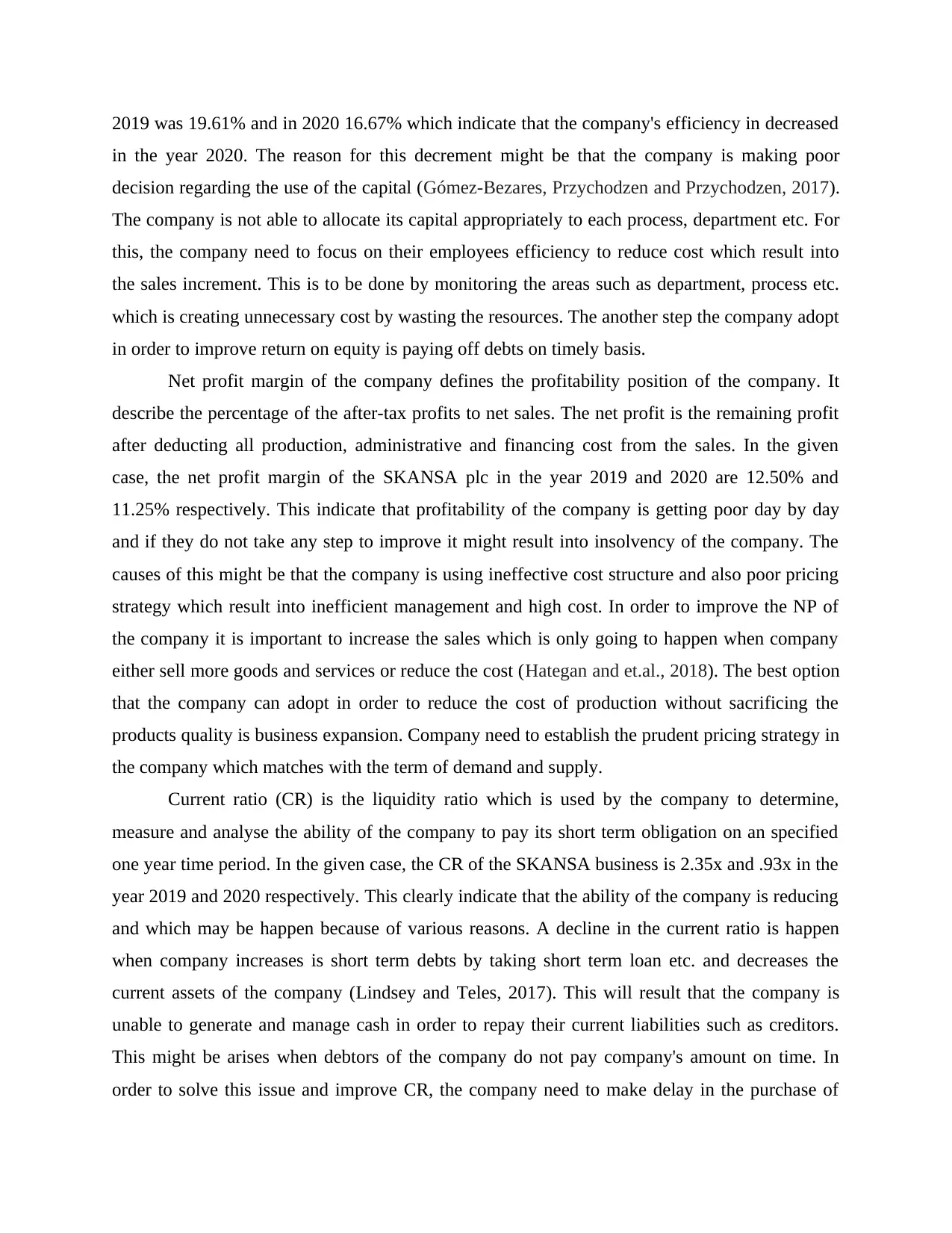
2019 was 19.61% and in 2020 16.67% which indicate that the company's efficiency in decreased
in the year 2020. The reason for this decrement might be that the company is making poor
decision regarding the use of the capital (Gómez‐Bezares, Przychodzen and Przychodzen, 2017).
The company is not able to allocate its capital appropriately to each process, department etc. For
this, the company need to focus on their employees efficiency to reduce cost which result into
the sales increment. This is to be done by monitoring the areas such as department, process etc.
which is creating unnecessary cost by wasting the resources. The another step the company adopt
in order to improve return on equity is paying off debts on timely basis.
Net profit margin of the company defines the profitability position of the company. It
describe the percentage of the after-tax profits to net sales. The net profit is the remaining profit
after deducting all production, administrative and financing cost from the sales. In the given
case, the net profit margin of the SKANSA plc in the year 2019 and 2020 are 12.50% and
11.25% respectively. This indicate that profitability of the company is getting poor day by day
and if they do not take any step to improve it might result into insolvency of the company. The
causes of this might be that the company is using ineffective cost structure and also poor pricing
strategy which result into inefficient management and high cost. In order to improve the NP of
the company it is important to increase the sales which is only going to happen when company
either sell more goods and services or reduce the cost (Hategan and et.al., 2018). The best option
that the company can adopt in order to reduce the cost of production without sacrificing the
products quality is business expansion. Company need to establish the prudent pricing strategy in
the company which matches with the term of demand and supply.
Current ratio (CR) is the liquidity ratio which is used by the company to determine,
measure and analyse the ability of the company to pay its short term obligation on an specified
one year time period. In the given case, the CR of the SKANSA business is 2.35x and .93x in the
year 2019 and 2020 respectively. This clearly indicate that the ability of the company is reducing
and which may be happen because of various reasons. A decline in the current ratio is happen
when company increases is short term debts by taking short term loan etc. and decreases the
current assets of the company (Lindsey and Teles, 2017). This will result that the company is
unable to generate and manage cash in order to repay their current liabilities such as creditors.
This might be arises when debtors of the company do not pay company's amount on time. In
order to solve this issue and improve CR, the company need to make delay in the purchase of
in the year 2020. The reason for this decrement might be that the company is making poor
decision regarding the use of the capital (Gómez‐Bezares, Przychodzen and Przychodzen, 2017).
The company is not able to allocate its capital appropriately to each process, department etc. For
this, the company need to focus on their employees efficiency to reduce cost which result into
the sales increment. This is to be done by monitoring the areas such as department, process etc.
which is creating unnecessary cost by wasting the resources. The another step the company adopt
in order to improve return on equity is paying off debts on timely basis.
Net profit margin of the company defines the profitability position of the company. It
describe the percentage of the after-tax profits to net sales. The net profit is the remaining profit
after deducting all production, administrative and financing cost from the sales. In the given
case, the net profit margin of the SKANSA plc in the year 2019 and 2020 are 12.50% and
11.25% respectively. This indicate that profitability of the company is getting poor day by day
and if they do not take any step to improve it might result into insolvency of the company. The
causes of this might be that the company is using ineffective cost structure and also poor pricing
strategy which result into inefficient management and high cost. In order to improve the NP of
the company it is important to increase the sales which is only going to happen when company
either sell more goods and services or reduce the cost (Hategan and et.al., 2018). The best option
that the company can adopt in order to reduce the cost of production without sacrificing the
products quality is business expansion. Company need to establish the prudent pricing strategy in
the company which matches with the term of demand and supply.
Current ratio (CR) is the liquidity ratio which is used by the company to determine,
measure and analyse the ability of the company to pay its short term obligation on an specified
one year time period. In the given case, the CR of the SKANSA business is 2.35x and .93x in the
year 2019 and 2020 respectively. This clearly indicate that the ability of the company is reducing
and which may be happen because of various reasons. A decline in the current ratio is happen
when company increases is short term debts by taking short term loan etc. and decreases the
current assets of the company (Lindsey and Teles, 2017). This will result that the company is
unable to generate and manage cash in order to repay their current liabilities such as creditors.
This might be arises when debtors of the company do not pay company's amount on time. In
order to solve this issue and improve CR, the company need to make delay in the purchase of
⊘ This is a preview!⊘
Do you want full access?
Subscribe today to unlock all pages.

Trusted by 1+ million students worldwide
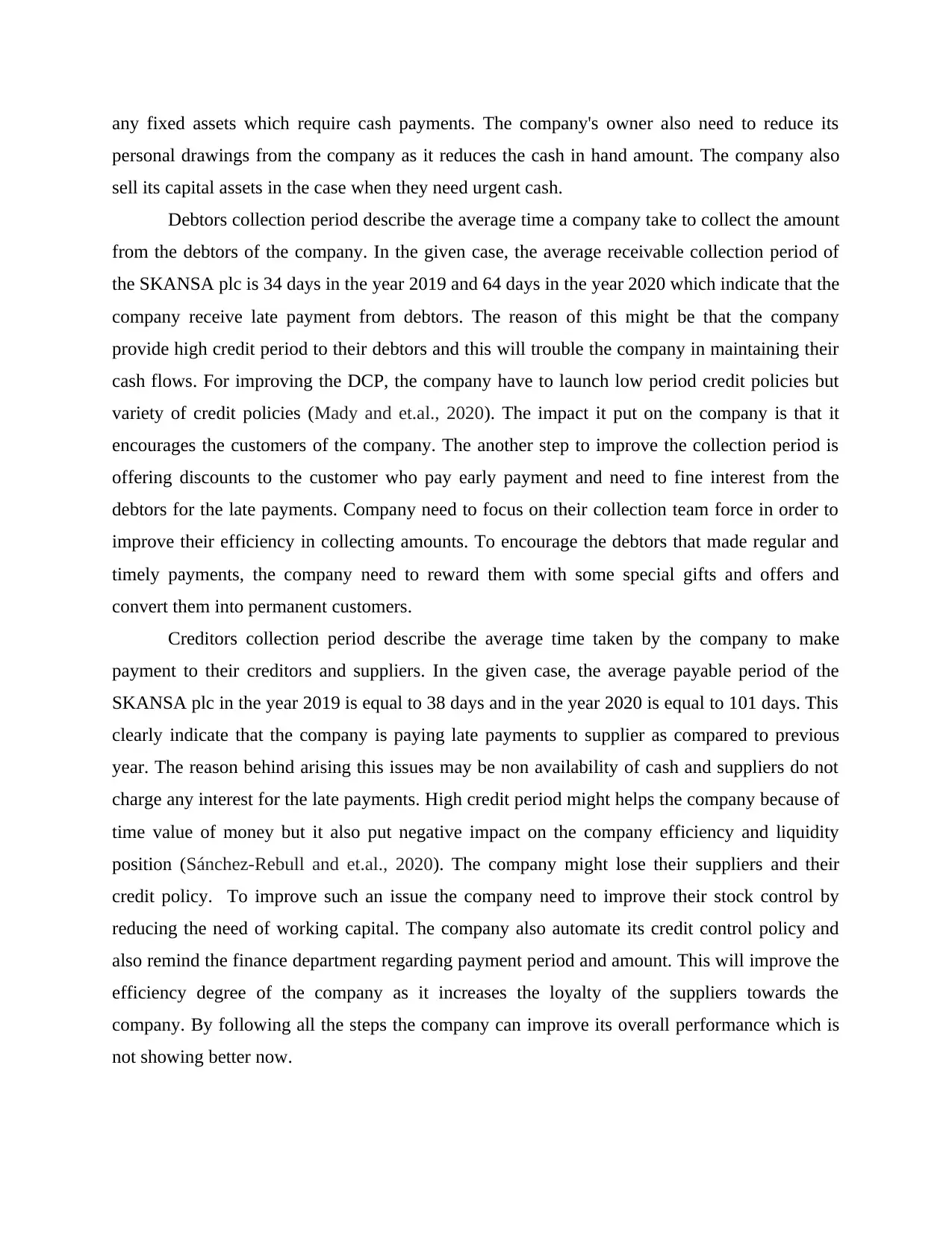
any fixed assets which require cash payments. The company's owner also need to reduce its
personal drawings from the company as it reduces the cash in hand amount. The company also
sell its capital assets in the case when they need urgent cash.
Debtors collection period describe the average time a company take to collect the amount
from the debtors of the company. In the given case, the average receivable collection period of
the SKANSA plc is 34 days in the year 2019 and 64 days in the year 2020 which indicate that the
company receive late payment from debtors. The reason of this might be that the company
provide high credit period to their debtors and this will trouble the company in maintaining their
cash flows. For improving the DCP, the company have to launch low period credit policies but
variety of credit policies (Mady and et.al., 2020). The impact it put on the company is that it
encourages the customers of the company. The another step to improve the collection period is
offering discounts to the customer who pay early payment and need to fine interest from the
debtors for the late payments. Company need to focus on their collection team force in order to
improve their efficiency in collecting amounts. To encourage the debtors that made regular and
timely payments, the company need to reward them with some special gifts and offers and
convert them into permanent customers.
Creditors collection period describe the average time taken by the company to make
payment to their creditors and suppliers. In the given case, the average payable period of the
SKANSA plc in the year 2019 is equal to 38 days and in the year 2020 is equal to 101 days. This
clearly indicate that the company is paying late payments to supplier as compared to previous
year. The reason behind arising this issues may be non availability of cash and suppliers do not
charge any interest for the late payments. High credit period might helps the company because of
time value of money but it also put negative impact on the company efficiency and liquidity
position (Sánchez-Rebull and et.al., 2020). The company might lose their suppliers and their
credit policy. To improve such an issue the company need to improve their stock control by
reducing the need of working capital. The company also automate its credit control policy and
also remind the finance department regarding payment period and amount. This will improve the
efficiency degree of the company as it increases the loyalty of the suppliers towards the
company. By following all the steps the company can improve its overall performance which is
not showing better now.
personal drawings from the company as it reduces the cash in hand amount. The company also
sell its capital assets in the case when they need urgent cash.
Debtors collection period describe the average time a company take to collect the amount
from the debtors of the company. In the given case, the average receivable collection period of
the SKANSA plc is 34 days in the year 2019 and 64 days in the year 2020 which indicate that the
company receive late payment from debtors. The reason of this might be that the company
provide high credit period to their debtors and this will trouble the company in maintaining their
cash flows. For improving the DCP, the company have to launch low period credit policies but
variety of credit policies (Mady and et.al., 2020). The impact it put on the company is that it
encourages the customers of the company. The another step to improve the collection period is
offering discounts to the customer who pay early payment and need to fine interest from the
debtors for the late payments. Company need to focus on their collection team force in order to
improve their efficiency in collecting amounts. To encourage the debtors that made regular and
timely payments, the company need to reward them with some special gifts and offers and
convert them into permanent customers.
Creditors collection period describe the average time taken by the company to make
payment to their creditors and suppliers. In the given case, the average payable period of the
SKANSA plc in the year 2019 is equal to 38 days and in the year 2020 is equal to 101 days. This
clearly indicate that the company is paying late payments to supplier as compared to previous
year. The reason behind arising this issues may be non availability of cash and suppliers do not
charge any interest for the late payments. High credit period might helps the company because of
time value of money but it also put negative impact on the company efficiency and liquidity
position (Sánchez-Rebull and et.al., 2020). The company might lose their suppliers and their
credit policy. To improve such an issue the company need to improve their stock control by
reducing the need of working capital. The company also automate its credit control policy and
also remind the finance department regarding payment period and amount. This will improve the
efficiency degree of the company as it increases the loyalty of the suppliers towards the
company. By following all the steps the company can improve its overall performance which is
not showing better now.
Paraphrase This Document
Need a fresh take? Get an instant paraphrase of this document with our AI Paraphraser

CONCLUSION
The report concludes the ratio analysis of the SKANSA company which includes the
return on capital employed, net profit margin, current ratio, debtors collection period and
creditors payment period. The report conclude the that the overall performance of the company is
poor in the current year as compared to the previous year. In order to improve the efficiency,
profitability and liquidity performance of the company, the managers need to adopt the various
strategy related to pricing, sales increment, debtors policy, creditors policy etc. The report also
concludes the importance of the accounting and finance in the business operations because
without finance nothing can be done in the business. In order to make it more understandable the
report will also conclude the examples within the SKANSA company. The report further
concludes that every company need to hire a well-qualified manager for the role of this tasks and
improver the efficiency of the employees of the company (Liang, Zhao and Hong, 2019).
The report concludes the ratio analysis of the SKANSA company which includes the
return on capital employed, net profit margin, current ratio, debtors collection period and
creditors payment period. The report conclude the that the overall performance of the company is
poor in the current year as compared to the previous year. In order to improve the efficiency,
profitability and liquidity performance of the company, the managers need to adopt the various
strategy related to pricing, sales increment, debtors policy, creditors policy etc. The report also
concludes the importance of the accounting and finance in the business operations because
without finance nothing can be done in the business. In order to make it more understandable the
report will also conclude the examples within the SKANSA company. The report further
concludes that every company need to hire a well-qualified manager for the role of this tasks and
improver the efficiency of the employees of the company (Liang, Zhao and Hong, 2019).
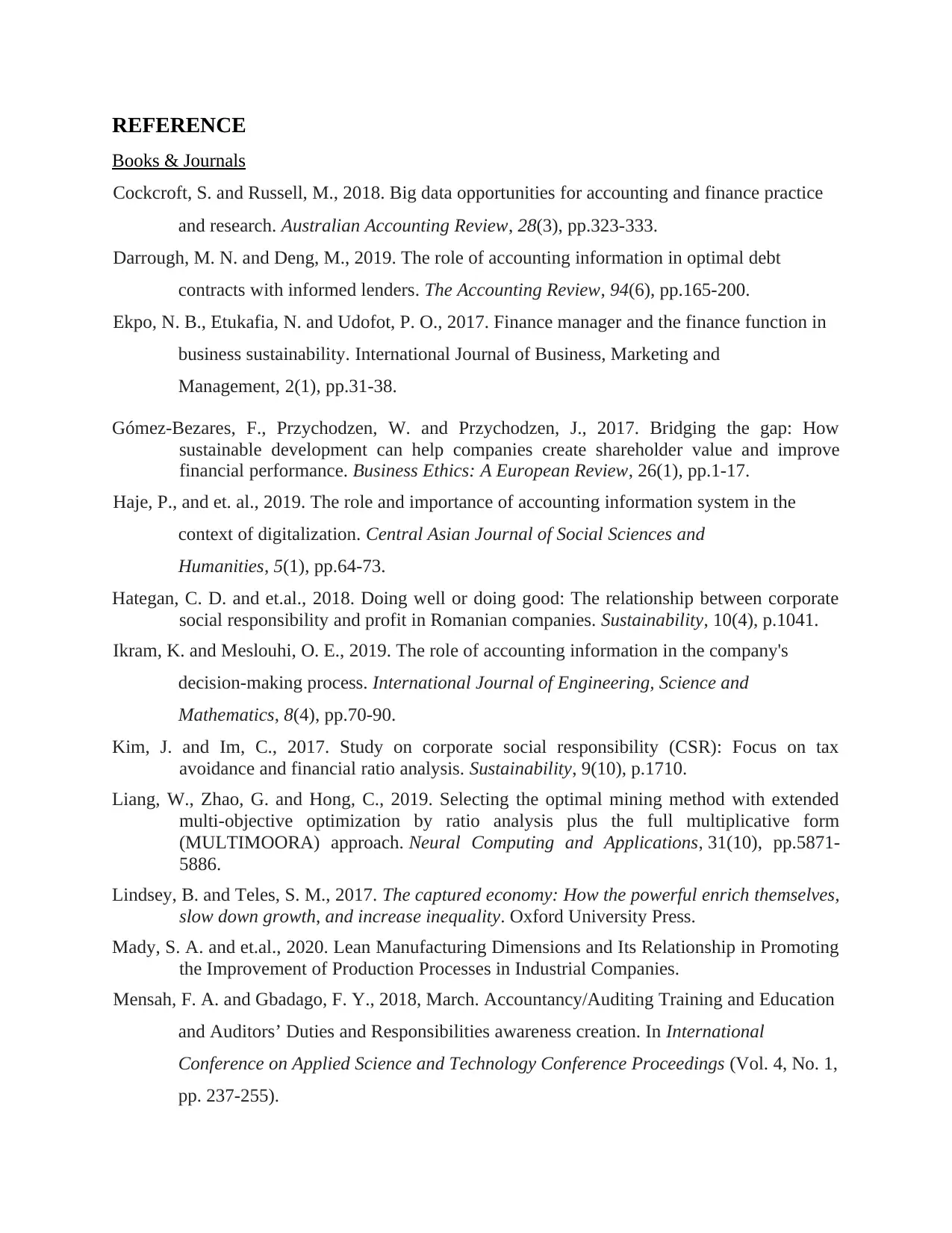
REFERENCE
Books & Journals
Cockcroft, S. and Russell, M., 2018. Big data opportunities for accounting and finance practice
and research. Australian Accounting Review, 28(3), pp.323-333.
Darrough, M. N. and Deng, M., 2019. The role of accounting information in optimal debt
contracts with informed lenders. The Accounting Review, 94(6), pp.165-200.
Ekpo, N. B., Etukafia, N. and Udofot, P. O., 2017. Finance manager and the finance function in
business sustainability. International Journal of Business, Marketing and
Management, 2(1), pp.31-38.
Gómez‐Bezares, F., Przychodzen, W. and Przychodzen, J., 2017. Bridging the gap: How
sustainable development can help companies create shareholder value and improve
financial performance. Business Ethics: A European Review, 26(1), pp.1-17.
Haje, P., and et. al., 2019. The role and importance of accounting information system in the
context of digitalization. Central Asian Journal of Social Sciences and
Humanities, 5(1), pp.64-73.
Hategan, C. D. and et.al., 2018. Doing well or doing good: The relationship between corporate
social responsibility and profit in Romanian companies. Sustainability, 10(4), p.1041.
Ikram, K. and Meslouhi, O. E., 2019. The role of accounting information in the company's
decision-making process. International Journal of Engineering, Science and
Mathematics, 8(4), pp.70-90.
Kim, J. and Im, C., 2017. Study on corporate social responsibility (CSR): Focus on tax
avoidance and financial ratio analysis. Sustainability, 9(10), p.1710.
Liang, W., Zhao, G. and Hong, C., 2019. Selecting the optimal mining method with extended
multi-objective optimization by ratio analysis plus the full multiplicative form
(MULTIMOORA) approach. Neural Computing and Applications, 31(10), pp.5871-
5886.
Lindsey, B. and Teles, S. M., 2017. The captured economy: How the powerful enrich themselves,
slow down growth, and increase inequality. Oxford University Press.
Mady, S. A. and et.al., 2020. Lean Manufacturing Dimensions and Its Relationship in Promoting
the Improvement of Production Processes in Industrial Companies.
Mensah, F. A. and Gbadago, F. Y., 2018, March. Accountancy/Auditing Training and Education
and Auditors’ Duties and Responsibilities awareness creation. In International
Conference on Applied Science and Technology Conference Proceedings (Vol. 4, No. 1,
pp. 237-255).
Books & Journals
Cockcroft, S. and Russell, M., 2018. Big data opportunities for accounting and finance practice
and research. Australian Accounting Review, 28(3), pp.323-333.
Darrough, M. N. and Deng, M., 2019. The role of accounting information in optimal debt
contracts with informed lenders. The Accounting Review, 94(6), pp.165-200.
Ekpo, N. B., Etukafia, N. and Udofot, P. O., 2017. Finance manager and the finance function in
business sustainability. International Journal of Business, Marketing and
Management, 2(1), pp.31-38.
Gómez‐Bezares, F., Przychodzen, W. and Przychodzen, J., 2017. Bridging the gap: How
sustainable development can help companies create shareholder value and improve
financial performance. Business Ethics: A European Review, 26(1), pp.1-17.
Haje, P., and et. al., 2019. The role and importance of accounting information system in the
context of digitalization. Central Asian Journal of Social Sciences and
Humanities, 5(1), pp.64-73.
Hategan, C. D. and et.al., 2018. Doing well or doing good: The relationship between corporate
social responsibility and profit in Romanian companies. Sustainability, 10(4), p.1041.
Ikram, K. and Meslouhi, O. E., 2019. The role of accounting information in the company's
decision-making process. International Journal of Engineering, Science and
Mathematics, 8(4), pp.70-90.
Kim, J. and Im, C., 2017. Study on corporate social responsibility (CSR): Focus on tax
avoidance and financial ratio analysis. Sustainability, 9(10), p.1710.
Liang, W., Zhao, G. and Hong, C., 2019. Selecting the optimal mining method with extended
multi-objective optimization by ratio analysis plus the full multiplicative form
(MULTIMOORA) approach. Neural Computing and Applications, 31(10), pp.5871-
5886.
Lindsey, B. and Teles, S. M., 2017. The captured economy: How the powerful enrich themselves,
slow down growth, and increase inequality. Oxford University Press.
Mady, S. A. and et.al., 2020. Lean Manufacturing Dimensions and Its Relationship in Promoting
the Improvement of Production Processes in Industrial Companies.
Mensah, F. A. and Gbadago, F. Y., 2018, March. Accountancy/Auditing Training and Education
and Auditors’ Duties and Responsibilities awareness creation. In International
Conference on Applied Science and Technology Conference Proceedings (Vol. 4, No. 1,
pp. 237-255).
⊘ This is a preview!⊘
Do you want full access?
Subscribe today to unlock all pages.

Trusted by 1+ million students worldwide
1 out of 14
Related Documents
Your All-in-One AI-Powered Toolkit for Academic Success.
+13062052269
info@desklib.com
Available 24*7 on WhatsApp / Email
![[object Object]](/_next/static/media/star-bottom.7253800d.svg)
Unlock your academic potential
Copyright © 2020–2025 A2Z Services. All Rights Reserved. Developed and managed by ZUCOL.





